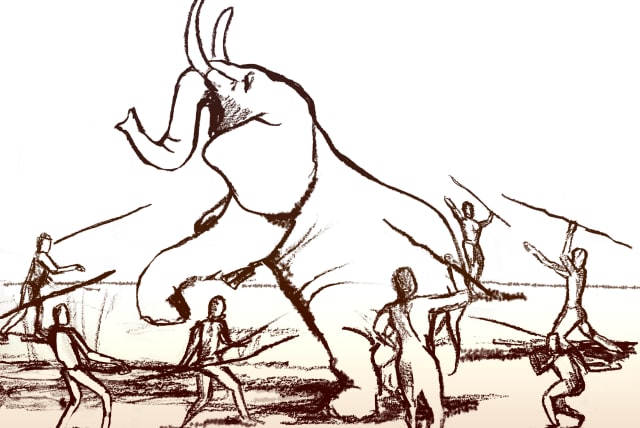New Tel Aviv University study claims connection with elephant hunting, Paleolithic quarries

Tel Aviv University archaeologists claim that elephant hunting by early humans was the reason for the proximity between Paleolithic extensive stone quarries and water sources
Why did the early humans called Homo erectus repeatedly revisit the very same locations for hundreds of thousands of years? It has long been a mystery among scientists. The answer lies in the migration routes of elephants that they hunted and dismembered using flint tools that they crafted at these quarrying sites.
Archaeologists at Tel Aviv University have uncovered the answer surrounding extensive Paleolithic stone quarrying and tool-making sites. The research was led by Dr. Meir Finkel and Prof. Ran Barkai of TAU’s Alkow Archaeology and Ancient Near Eastern Cultures Department. They published their study in the journal Archaeologies under the title “Quarries as Places of Significance in the Lower Paleolithic Holy Triad of Elephants, water, and Stone.”
Prehistoric research usually connects elephant butchering sites and stone tools to process the animal. Still, scholars have often neglected to examine the quarry sources for stone tools found at elephant butchering sites. Studies of the very long Lower Paleolithic period show that immense quantities of stone must have been procured, shaped, transported, used, and discarded.
Immense quantities of stone were studied
The extreme wealth of stone-tool assemblages retrieved at Lower Paleolithic sites bears silent testimony to the centrality of stone acquisition and use in the deep past. Barkai explained that “ancient humans had to have three things – water, food, and stone. While water and food are necessities for all creatures, humans relied on stone tools to hunt and butcher animals, as they lacked the sharp claws or fangs of other predators.
The question is, why do we find rock outcrops that were used to produce flint tools surrounded by thousands of stone tools, and next to them, rock outcrops containing flint that was not used to produce tools? “A study of indigenous groups that lived until recently, with some still alive today, shows that hunter-gatherers attribute great importance to the source of the stone – the quarry itself – imbuing it with power and sanctity, and hence also spiritual worship.
People have been making pilgrimages to such sites for generations, leaving offerings at the rock outcrop (visible exposures of bedrock or other geologic formations at the surface of the Earth.) In contrast, adjacent outcrops equally suitable for stone tool production remain untouched. We sought to understand why; what is special about these sites?” Barkai said.
For nearly 20 years, he and his colleagues have been researching flint quarrying and tool-making sites in the Upper Galilee. These sites are characterized by large nodules of flint that are convenient for crafting. They are within walking distance of the major Paleolithic sites of the Hula Valley – Gesher B’not Ya’akov and Ma’ayan Baruch. These sites boast thousands of quarrying and extraction localities where prehistoric humans fashioned tools until half a million years ago in the Lower Paleolithic period. They left offerings despite the presence of flint in other geological formations in various places.
Because elephants were the primary dietary component for these early humans, the researchers cross-referenced the database of the sites’ distribution with the database of the elephants’ migration routes. They discovered that the flint quarrying and knapping sites were in rock outcrops near the elephants’ migration paths.
“An elephant drinks an average of 400 liters daily, and that’s why it has fixed movement paths,” Finkel added. “These are animals that rely on a daily supply of water and therefore on water sources – the banks of lakes, rivers, and streams. We often discover elephant hunting and processing sites at “necessary crossings” – where a stream or river passes through a steep mountain pass or when a path along a lakeshore is limited to the space between the shore and a mountain range.”
At the same time, given the absence of available means of preservation and the presence of predatory animals in the area, the window of opportunity for a group of hunter-gatherers to exhaust their elephant prey was limited. Therefore, Finkel continued, “It was vital to prepare suitable cutting tools in large quantities in advance and nearby. For this reason, we find quarrying and knapping sites in the Upper Galilee located a short distance from elephant butchering sites, which are positioned along the elephants’ movement paths.”
The researchers sought to apply an adapted model from the one they developed in Israel to several sites from the Lower Paleolithic period in Asia, Europe, and Africa, where such a “triad” exists. These included sites where elephants or mammoths were the hunted animals and later sites where other animals, such as hippos, camels, and horses, were the prey.
“It appears that the Paleolithic holy trinity holds true universally: Wherever there was water, there were elephants, and wherever there were elephants, humans had to find suitable rock outcrops to quarry stone and make tools in order to hunt and butcher their favorite mega herbivores,” Barkai concluded. “It was a tradition – for hundreds of thousands of years, the elephants wandered along the same route, while humans produced stone tools nearby. Ultimately, those elephants became extinct, and the world changed forever.”
Jerusalem Post Store
`; document.getElementById("linkPremium").innerHTML = cont; var divWithLink = document.getElementById("premium-link"); if (divWithLink !== null && divWithLink !== 'undefined') { divWithLink.style.border = "solid 1px #cb0f3e"; divWithLink.style.textAlign = "center"; divWithLink.style.marginBottom = "15px"; divWithLink.style.marginTop = "15px"; divWithLink.style.width = "100%"; divWithLink.style.backgroundColor = "#122952"; divWithLink.style.color = "#ffffff"; divWithLink.style.lineHeight = "1.5"; } } (function (v, i) { });

